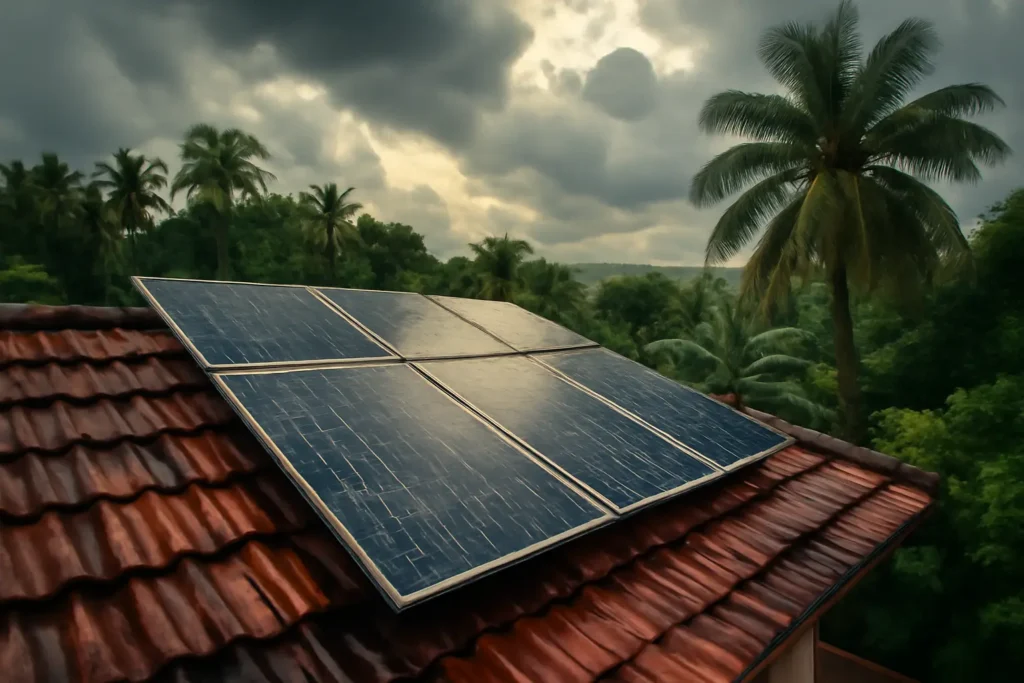How Long a Solar Panel Lasts in Kerala Climate?
For homeowners and businesses considering renewable energy, one of the most common inquiries is: how long a solar panel lasts? This is especially essential in areas like Kerala, where high humidity, heavy monsoons, and year-round sunlight offer ideal conditions for solar energy systems. Understanding solar panel longevity is crucial for informed investment planning and accurate long-term profit forecasting. Now, let’s look at some frequent criteria before making a final decision.

General Lifespan of Solar Panels
Most solar panels have a 25–30-year lifespan on average. This does not mean they stop producing electricity beyond that time, but their efficiency steadily declines. Manufacturers often issue 25-year performance warranties, guaranteeing that the panels continue to produce at least 80% of their rated output even after two and a half decades.
What Is the Typical Degradation Rate of Solar Panels Over Time?
As solar panels age, their capacity to turn sunlight into power gradually declines annually due to natural degradation. Degradation rates typically range from 0.5% to 0.8% annually. Panels may wear more quickly in Kerala’s tropical climate due to heat, humidity, and monsoon conditions, but with regular care, their lifespan remains robust and dependable.
Factors Affecting Solar Panel Efficiency in Kerala
Several climatic and technical factors affect how long a solar panel lasts.
- Climate conditions: Rainfall and high humidity can damage panel materials if they are not adequately sealed.
- Dust and salt deposits: Coastal areas can produce more residue buildup, limiting efficiency if not cleaned regularly.
- Quality of installation: A properly installed system is better equipped to handle monsoon winds and torrential rains, etc.
Lifespan of Different Types of Solar Panels in Kerala
- Monocrystalline Solar Panels: They are known for their durability and great efficiency, and can survive for 25-30 years with minimal degradation.
- Polycrystalline Solar Panels: Slightly less efficient, but still durable, lasting approximately 20-25 years on average.
- Thin-Film Solar Panels: More reasonably priced, but more susceptible to Kerala’s humid environment and having a shorter lifespan—typically 10 to 15 years.
- Bifacial Solar Panels: A modern technique that absorbs sunlight from both sides, generally lasting 25 years or more, and having exceptional durability when installed in open spaces.
Check out our Blog for a more in-depth explanation of the different types of solar panels.
Environmental Conditions in Kerala
Kerala’s tropical climate makes it an ideal location to install solar power plants. The state has a great deal of potential for solar power generation because of its year-round sunshine. However, the long-term performance and longevity of solar panels are also challenged by the same climate that promotes renewable energy.
How Does Humidity Impact Solar Panel Lifespan?
High humidity is a year-round occurrence in Kerala, particularly during the monsoon and post-monsoon seasons. Airborne moisture can slowly infiltrate into the materials of solar panels, causing delamination, decreased efficiency, and quicker electrical component wear. If the panels are not of superior quality or if installation does not guarantee adequate sealing, this could eventually reduce their lifespan.
What Environmental Factors in Kerala Affect Solar Panel Performance?
- Impact of Monsoon Rains: Kerala’s intense and lengthy monsoon rains naturally clean panels, but they also expose them to strong winds, waterlogging hazards, and debris damage. Improperly installed systems are more susceptible to storm-related problems.
- Intense Sunlight: Even though Kerala gets a lot of sunlight, too much heat can cause thermal stress, which, over time, can impair the semiconductor performance of the panel.
- Dust & Vegetation: In rural and agricultural locations, dust, pollen, and leaves can collect on panels, obstructing sunlight and limiting performance if not cleaned on a regular basis.
Solar Panel Corrosion Issues in Coastal Kerala
An additional major problem in Kerala’s coastal areas is the salty air. Salt particles can accumulate on solar panels and increase the deterioration of metal connectors, junction boxes, and frames. This not only affects efficiency, but it can also raise safety concerns if left uncontrolled. Superior-performing, corrosion-proof panels and protective finishes are recommended for installations near the sea to ensure durability.
Solar Panel Brands & Durability
When investing in solar energy, brand reliability and dependability are critical factors in evaluating how well panels operate in Kerala’s harsh climate. Not all panels are intended to survive high humidity, severe rains, and salt exposure, so selecting the proper brand ensures long-term success.
What Are the Best Solar Panels for Humid Climates?
Monocrystalline and bifacial panels from reputed manufacturers typically perform well in humid climates such as Kerala. These panels are more resistant to moisture and heat stress since they are designed with robust protective coatings and anti-corrosion compounds. High-quality encapsulation and robust glass coatings help to reduce long-term wear.
Which Solar Panel Brands Are Most Durable in Tropical Regions?
Well-known brands that have demonstrated resilience in tropical and coastal areas include Havells, Deye, Enphase, Adani Solar, WAAREE, Growatt, and Microtek. Their panels are resistant to moisture, salt mist, and intense monsoon rains since they are constructed with cutting-edge sealing methods. These brands frequently back their products with robust performance warranties, providing Kerala homeowners and businesses with further peace of mind.
Maintenance & Care
Even though solar panels are meant to be low-maintenance, Kerala’s tropical climate necessitates routine maintenance for longevity and efficiency.
What Maintenance Is Needed to Extend the Lifespan of Solar Panels in Humid Climates?
Regular cleaning to get rid of dust, salt, and organic deposits, along with recurring inspections to look for corrosion, loose wiring, or water seepage, are standard maintenance procedures in humid regions like Kerala. Proper maintenance plays a key role in how long a solar panel lasts.
How Often Do Solar Panels Need Maintenance in Kerala?
Solar panels in Kerala should be cleaned once every 2-3 months, with more regular cleaning needed in coastal and agricultural areas. Professional inspections should be performed at least once a year to verify that the system is operating at peak efficiency.
Check this blog to know about how to clean solar panels.
Warranty & Replacement
When it comes to solar panels in Kerala, warranties and replacement cycles are critical considerations for long-term planning.
- Solar Panel Warranty in Kerala: Most premium solar panels come with a 25-year performance warranty, which guarantees at least 80% efficiency at the conclusion of the warranty period. Many brands also offer a 10-15-year product warranty that covers manufacturing problems.
- Replacement Cycle for Solar Rooftop Systems in Kerala: A solar rooftop system may require component upgrades, such as inverters or batteries, every 8-12 years, whereas panels typically last 25-30 years before needing to be replaced.
Why Choose Neal Solar?
At Neal Solar, the best solar installation company in Kerala, we provide sustainable energy solutions that are suited to Kerala’s particular climate by combining top-notch solar technology, skilled installation, and committed support. Long-lasting systems that can endure humidity, monsoon rains, and coastal conditions while delivering dependable power for decades are guaranteed by our emphasis on quality.
FAQ
Do more expensive solar panels last longer in humid climates?
Yes, premium solar panels are typically constructed with superior sealing, stronger materials, and cutting-edge anti-corrosion technology, which increases their durability in humid areas like Kerala. While the initial expenses are higher, they often last longer and come with extended warranties.
What are the long-term cost benefits of high-quality solar panels in tropical areas?
High-quality solar panels may be more expensive initially, but they provide higher efficiency, longer warranties, and slower deterioration rates. In tropical countries like Kerala, this equates to higher energy savings over 25-30 years, lower maintenance costs, and fewer replacements, maximising overall return on investment.
What is the solar panel efficiency drop per year in Kerala?
Solar panels typically deteriorate between 0.5% and 0.8% year, but in Kerala’s humid and coastal climate, this rate could be somewhat higher if adequate maintenance is not done. Most panels in Kerala still operate at over 80% of their rated efficiency after 25 years of good installation and routine cleaning.
